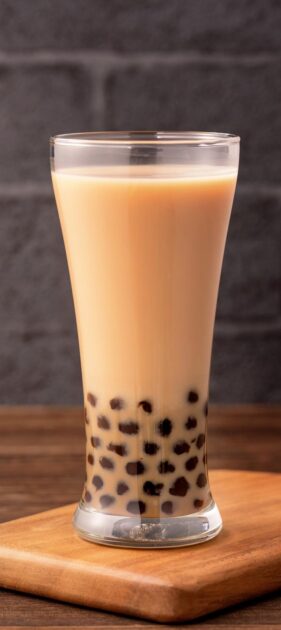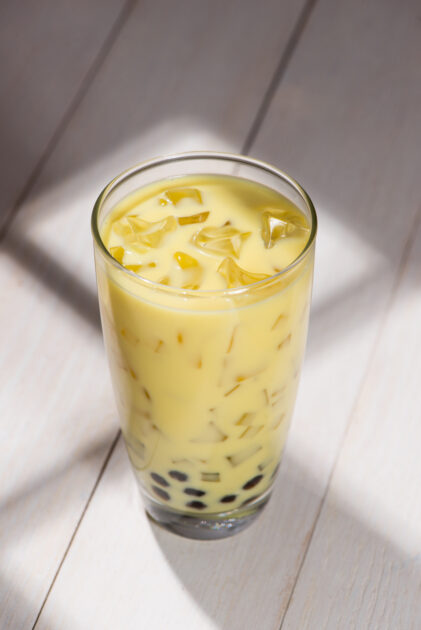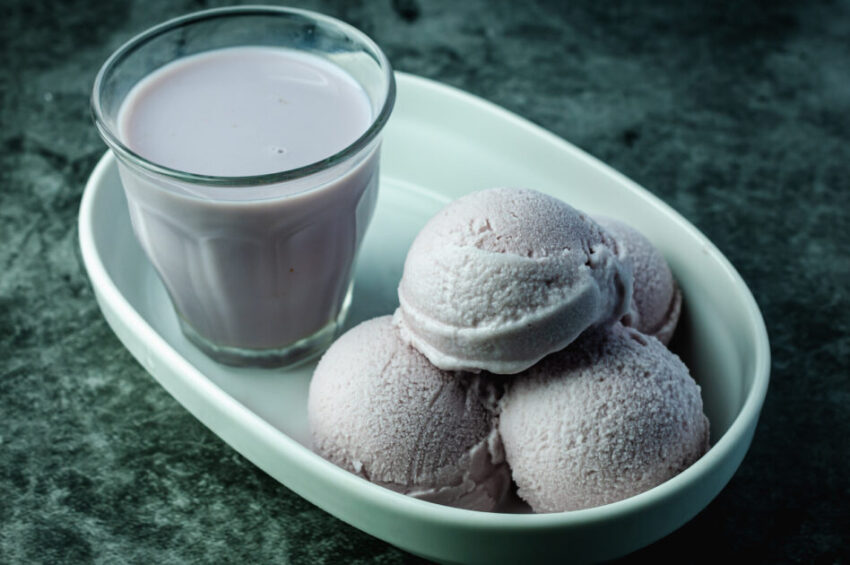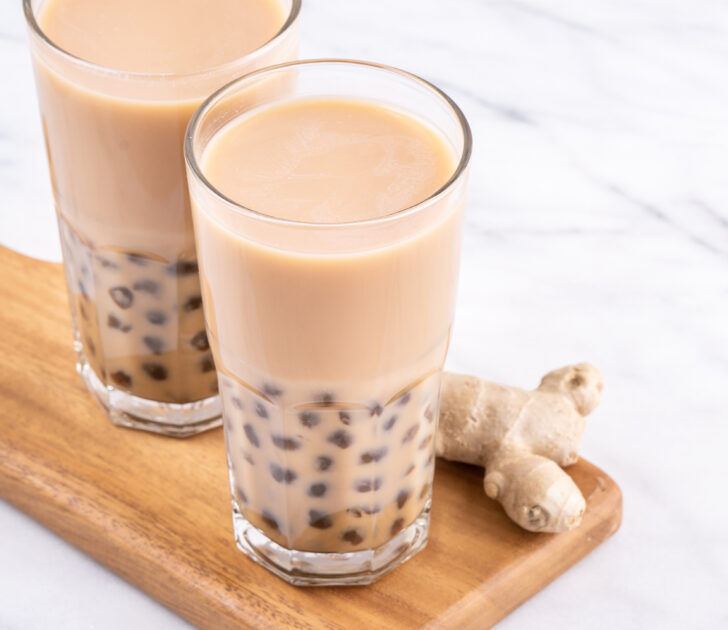Intro
Taro milk tea also called taro bubble tea or taro boba tea is a popular tea-based drink that was created in Taiwan, known for its bright purple color. If you have ever wandered into a boba milk tea shop here in the United States and seen this drink on the menu, you might be wondering about the taro taste.
When used to make taro milk bubble tea, taro root has a sweet taste with a nutty flavor similar to purple sweet potatoes or purple yam. Taro milk tea tastes differently depending on which type of tea base, dairy products, sweetener, and boba pearls are used in the taro milk tea recipe. Additionally, real taro can be prepared in many different ways, including savory dishes, taro smoothies, taro chips, or taro ice cream.
In this article, we’ll discuss the origin of the taro plant, the taste of taro, how to make taro milk tea at home, and other uses for taro. Keep reading to learn all about this interesting vegetable!

What Is Taro?
Taro, or colocasia esculenta, is a starchy root vegetable from a tropical plant that is native to Southeast Asia. History leads us to believe that taro was one of the very first plants to be cultivated. Today, it is one of the main ingredients in many Asian, Caribbean, African, and Pacific Islander dishes.
It has brown skin and white flesh with purple flecks that give it purple coloring when mixed into other dishes. In America, the most similar vegetables are sweet potato or purple yam. You can cook and eat the leaves of the taro plant, but the most popular way to use taro is to use the root. This is the part that is mashed and combined with tea in delicious taro milk tea. Fresh taro root is an amazing source of fiber and other nutrients.

Taro Health Benefits
As we mentioned earlier, taro root and taro powder have a ton of amazing health benefits. The vegetable is high in fiber and other vitamins, minerals, and antioxidants such as vitamins C, E, potassium, and manganese.
Consuming taro can lead to the following health benefits:
Lower blood sugar levels
Decrease the risk of heart disease
Prevent cancer-causing cells
Contribute to healthy weight loss
Maintain a healthy immune system
What Does Taro Milk Tea Taste Like?
Taro tea has a unique flavor, often described as a nutty vanilla flavor with a creamy texture. This popular drink can be made in many variations, especially at boba tea shops that have a ton of different ingredients. Every taro milk tea has distinct tastes and flavors based on its ingredients.
The vanilla-like flavor of taro can be mixed with different teas, milk, sugars, and chewy tapioca balls based on personal preference. The creamy taste comes mostly from the milk. Mixed with the taro flavor, these other ingredients combine to create different flavors of bubble milk tea.

How To Make Taro Milk Tea At Home
If you want to have the taro boba taste at home just like at the bubble tea shops, you’ve come to the right place! You can find raw taro or taro root powder at your local Asian grocery store. Additionally, you’ll see that the recipe can be customized to your liking based on preference.
Ingredients Needed:
- 1 cup of taro root
- 4 cups of water
- Tea bags (black tea is recommended, but you can use green or jasmine tea as well)
- 1 cup of milk (Choose between whole milk, coconut milk, oat milk, almond milk, soy milk, or any other kind of milk/non-dairy creamer)
- 1/4 cup of sweetener (Can sugar, simple syrup, maple syrup, honey, agave nectar, or brown sugar syrup)
- 1/2 cup of black tapioca pearl
How to Make Taro Milk Tea:
- Bring water to a boil at medium heat and add the taro root, let simmer for approx. 15 minutes
- Remove the taro root from the hot water and let it cool to room temperature
- Once cool, mash the taro root into a paste
- Brew your tea of choice in 1 cup of water, remove tea bad once brewing is complete
- Combine the mashed taro root, your choice of milk, and sweetener in a blender and blend until smooth
- Add tapioca pearls, tea, and blended taro milk to a cup with some ice cubes, and enjoy!

Different Ways To Use Taro
Taro root or taro powder can be used in many other dishes besides taro milk tea. This vegetable is often one of the main ingredients in Asian, Caribbean, African, and Pacific Islander dishes. Taro can be boiled, steamed, fried, and roasted. Cooking taro in different ways can produce different flavors. For example, taro brings a sweet vanilla taste to desserts and sweet treats, but a nutty or salty flavor to savory dishes. Below are some of the other popular dishes you’ll find taro in:
Taro Chips
Taro can be roasted and baked, just like a potato to create a golden brown chip. Many people will season the taro before roasting to give it another flavor, just like you see chips at the grocery store with different flavors. Roasted taro tastes like a parsnip, slightly dry and chewy.
Taro Ice Cream
Taro ice cream is similar to the flavor you will find in taro milk tea, only colder! The ice cream retains the sweet and nutty flavor of taro, except it is churned with much more milk. It is a common flavor of ice cream in Asia.
Poi
Poi is a famous condiment in Hawaii. It is made by fermenting taro. The fermentation process creates a tangy flavor in addition to taro’s naturally sweet flavor.
Taro Cake
Taro Cake is a staple of many different cultures, including Cantonese and Mexican. The Cantonese cake is dense and soft, with a nutty flavor. The Mexican version, called Conchas, is more of a sweet bread that is less moist than Cantonese cake.

Summary
Taro milk tea is a popular boba tea flavor. Many people think the bright purple coloring of the tea drink comes from food coloring, but it comes from a Southeast Asian vegetable called taro, or colocasia esculenta.
When used to make taro bubble tea, the taro root produces a sweet, nutty flavor that is similar to purple sweet potatoes or purple yam. The popular drink can be made with different teas, milk, sugars, and chewy tapioca balls to create different flavors and textures based on personal preference. You can purchase taro milk tea at a boba shop or make it at home by boiling and mashing fresh taro root.
Beyond boba tea, taro can also be used in many other ways, including frying, roasting, baking, and fermenting. Preparing taro in different ways can produce a different flavor. It is often described as salty and nuttier when used in savory dishes. Taro is often one of the main ingredients in cultural dishes such as Mexican Conchas, Hawaiian Poi, and South Indian Sukhi Arbi.
We hope you enjoyed learning about the origin, taste, and various uses of taro!
Check out our post: THE BEST TEA REMEDY: QUICK RELIEF FOR A TOOTHACHE!
Sources:

Pingback: THE TYPES OF JAPANESE TEA CUPS THAT YOU’LL WANT TO OWN NOW
Pingback: IS KUNG FU TEA BRAND VEGAN? READ THIS GUIDE NOW! -
Pingback: IS TARO TEA GOOD FOR YOU? WE’LL ANSWER RIGHT NOW -